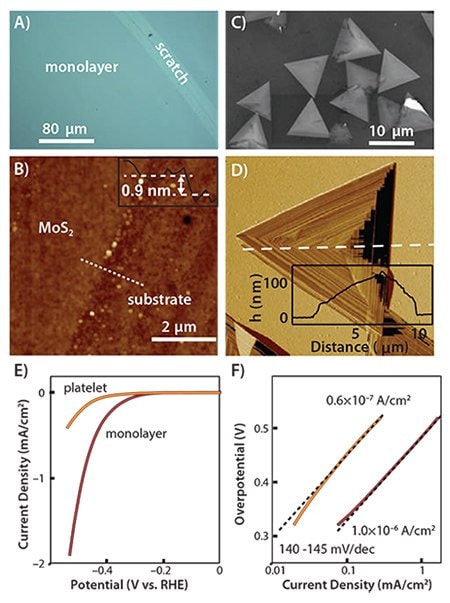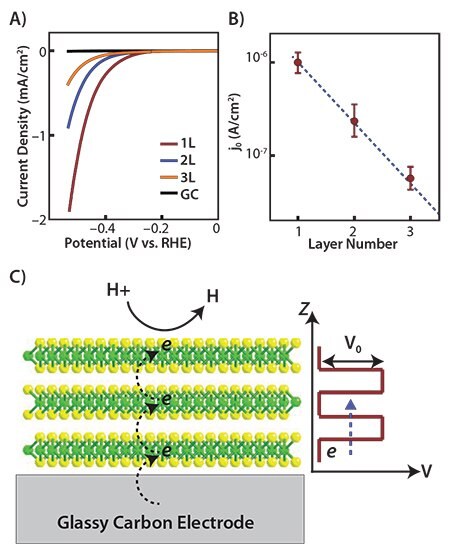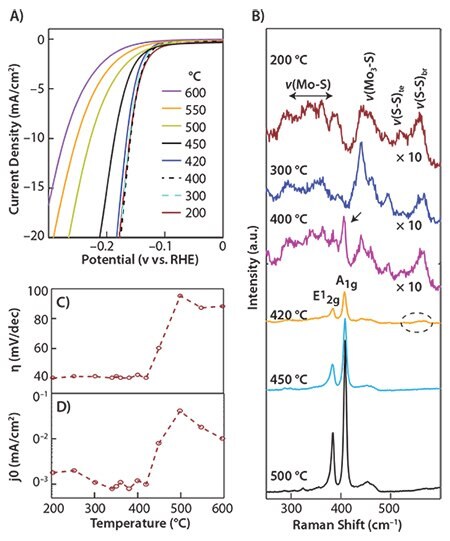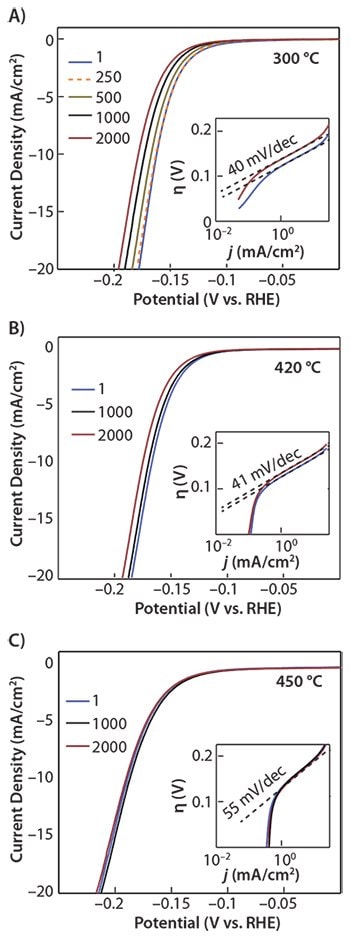Molybdenum Disulfide: Hydrogen Evolution
Linyou Cao
Department of Materials Science and Engineering Department of Physics North Carolina State University, Raleigh, NC, USA
Introduction
The production of hydrogen by catalytic water splitting is important for a wide range of industries including renewable energy petroleum refining and for the production of methanol and ammonia in the chemical industry. Within the renewable energy field, hydrogen is an attractive candidate for the storage of energy produced by intermittent renewable energy sources such as solar and wind. Hydrogen is an important chemical feedstock for refining petroleum to produce methanol and ammonia. Within the chemical industry, hydrogen produced from catalytic water splitting has a higher purity and a lower environmental impact than that produced by steam-methane reforming, currently the most common process used for hydrogen production. Despite its significant potential, the widespread adoption of catalytic water splitting has been delayed due to a lack of ideal catalysts with high performance and low cost.
Platinum (Pt) (685453) is the most widely used catalyst for the hydrogen evolution reaction (HER) in water. It shows excellent catalytic performance but is much too costly for the mass production of hydrogen. Molybdenum sulfide, an earth abundant metal dichalcogenide, is considered a promising alternative.1–3 Various molybdenum sulfide materials with different composition (molybdenum disulfide (MoS2; 234842) or trisulfide) and morphology (such as nanoparticles, nanotubes, amorphous, or single crystalline MoS2) have been examined as catalysts for the HER. While significant progress has been achieved, molybdenum sulfide materials are still less effective catalysts than Pt. More effort is necessary to improve their performance to make them a useful HER catalyst for practical applications.
A limited understanding of the catalytic reaction currently constrains development of a high-performance molybdenum sulfide HER catalyst. Catalytic performance is indicated by three main material parameters: exchange current density (turnover frequency), Tafel slope, and stability. The development of an ideal catalyst requires synergistic optimization to achieve high exchange current density, low Tafel slope, and high stability. However, the understanding of how each of these parameters depends on the physical features of molybdenum sulfide materials continues to be elusive. For instance, it has been widely believed that the edge sites of molybdenum disulfide (MoS2) are catalytically active and the exchange current density is linearly dependent on the number of edge sites,4 but recent studies have suggested that the electrical conductivity of the materials also plays an important role in the exchange current density.5–8
This article reviews the latest progress in understanding of the catalytic HER at MoS2. In particular, the new understanding on how the three key parameters (exchange current density, Tafel slope, and stability) depend on the compositional and structural features of molybdenum sulfide materials is presented. We also provide perspectives on the rational design toward the development of high-performance and cost-effective HER catalysts.
Exchange Current Density: Edge Sites and Electrical Conductivity
Exchange current density represents the rate of the catalytic reaction under thermodynamic equilibrium. Conventional wisdom states that the edge site plays an overwhelmingly important role in the catalytic performance and the exchange current density is linearly dependent on the number of edge sites.4,9 This notion is primarily based on theoretical simulations demonstrating the free energy of the adsorption of hydrogen atoms at the edge site is small;10 as well as experimental results that show that the exchange current density is dependent on the length of the edge instead of the area of the catalyst materials.4 However, our recent studies have indicated this well-accepted notion overlooks the important role of electrical conductivity in the exchange current density.8
Examination of the catalytic performance of two different types of MoS2 materials with different numbers of edge sites found that the exchange current density is strongly dependent on the electrical conductivity of the materials, rather than the number of edge sites. One material is a continuous, uniform, and atomically thin MoS2 film with controlled layer numbers (Figure 1A–B), where we confirmed no substantial amount of edge sites. The other is a triangular MoS2 pyramid platelet (Figure 1C–D). The platelet is formed by dislocation-driven growth and its surface is fully covered by edge sites. Both the film and the platelet are synthesized using similar chemical vapor deposition (CVD) processes under identical temperatures (850 °C) and are expected to have comparable crystallinity.8,11 In stark contrast with the well-accepted notion, the platelet structure, which is expected to have higher exchange current densities due to the larger number of edge sites, shows an order of magnitude lower value than that of monolayer MoS2 (Figure 1E–F). Additionally, the exchange current densities of the film and the platelet both substantially decrease with increasing thickness. On the other hand, the Tafel slope does not show much variation between the two materials or with the change of layer numbers.

Figure 1.Catalytic performance of MoS2 monolayer films and pyramid platelets. A) Optical image and B) AFM image of a monolayer MoS2 film on glass carbon substrates. A scratch is intentionally introduced to show the contrast between the substrate and the film and for the convenience of characterizing the height of the film. The inset of B) is a typical height profile of the film. C) AFM image and D) SEM image of typical pyramid platelets on glass carbon substrates. The inset of C) shows a typical height profile for the platelet. E) Polarization curve and F) Tafel plot of the MoS2 monolayer film and pyramid platelets. The Tafel slope and exchange current density are given in F) as shown.8
The experimental results indicate the electrical conductivity of MoS2 materials plays an important role in the exchange current density. The results obtained on MoS2 films are used to illustrate this notion. The exchange current density of the film decreases by 4.45 times with the addition of every new layer (Figure 2A–B). This can be explained by the layer dependence of the electrical conductivity. As shown in Figure 2C, the electron must transfer from the electrode to the surface in order to drive the catalytic reaction at the surface of MoS2. The charge transfer in the vertical direction of the MoS2 material occurs through tunneling, due to the presence of a van der Waals gap.12 We can correlate the layerdependent exchange current density to the efficiency of the electron tunneling, which is expected to decrease with the increasing number of layers and can, therefore, derive the potential barrier in the interlayer gap to be Vo = 0.119 V. This result is consistent with the theoretical studies, which predicts the interlayer potential barrier of MoS2 to be 0.123 V.13

Figure 2. Layer dependence of the catalytic activities of MoS2 films. A) Polarization curves of the synthesized monolayer (red, 1L), bilayer (blue, 2L), and trilayer (orange, 3L) MoS2 films. The curve of bare glass carbon substrates is also given (black). B) The exchange current density of the MoS2 film as a function of the layer number. The current density is plotted in a logarithmic scale. The dashed line is a fitting of logy = –0.65x–5.35. C) Schematic for the hopping of electrons in the vertical direction of MoS2 layers. The right side illustrates the potential barrier in the interlayer gap.8 Copyright 2010 American Chemical Society.
The electrocatalytic reaction involves a two charge transfer processes, in which (1) electrons from the surface of the catalyst flow to the proton in the electrolyte solution, which may give rise to hydrogen atoms adsorbed on the surface as intermediate products, and (2) electrons from the electrode (glassy carbon) underneath the catalyst flow to the surface of the catalyst. Under thermodynamic equilibrium, the exchange current density essentially represents the overall charge transfer rate from the electrode to the proton. The role of the active site is to facilitate the first charge transfer by enabling a small free energy of adsorption for hydrogen atoms. Previous theoretical studies have demonstrated that the rate of the first charge transfer is the highest when the free energy of adsorption is close to zero.10,14 In contrast, the electrical conductivity may affect the rate of the second charge transfer as just discussed. It should be pointed out that the effect of electrical conductivity on the charge transfer rate is different from the potential drop caused by the electrical resistance of catalyst materials and the latter may be eliminated by performing iR correction.
According to this understanding, the exchange current density can be improved either by increasing the number of active sites, which has been the major strategy used to date, or by increasing the conductivity of the materials. Many recent studies have demonstrated an improvement in the catalytic performance of MoS2 as the result of improved electrical conductivity. In fact, a significant improvement in the catalytic performance has been reported by changing the crystalline phase of MoS2 from 2H to 1T. The 1T phase is known to be more conductive than the 2H phase.5–7 Additionally, cobalt and nickel doped MoS2 show improved catalytic performance,15 which could be ascribed to the improvement in electrical conductivity as well. As a result of the difference in electrical conductivity, crystalline molybdenum sulfide materials can enable much higher exchange current densities than amorphous counterparts (Figure 3D).16
Tafel Slope: Disorder in Crystallinity
Tafel slope indicates the dependence of the catalytic reaction rate on applied overpotentials. The lower the Tafel slope, the faster the reaction rate increases with applied overpotentials. Generally, the Tafel slope (η) of an electrochemical reaction is dictated by the rate-determining step of the reaction and can be written as a function of the number of electrons involved (z) and the charge transfer coefficient (α) of the rate-determining step as η = 2.3zRT/αF,14,17 where R is the ideal gas constant, T is the absolute temperature, and F is the Faraday constant. For the HER of molybdenum sulfide materials, which usually occurs in acid media, there are three reaction steps that could be involved:
- the primary discharge step (Volmer reaction):
H3O+ + e- → Hads + H2O - an electrochemical desorption step (Heyrovsky reaction):
Hads + H3O+ + e- → H2 + H2O - a recombination step (Tafel reaction):
Hads + Hads → H2
It is well known that the Tafel slope of the HER would be different depending on which reaction is the rate-determining step because each of the reactions has a different charge transfer coefficient (α). More specifically, the Tafel slope would be 120 mV/decade, 40 mV/decade, and 30 mV/decade when the rate-determining step is reaction (1), (2), and (3), respectively. The Tafel slope may also be another value if the ratedetermining step involves more than one of the three reactions. The Tafel slope of the HER at molybdenum sulfide reported in the literature shows broad variation in the range of 40–140 mV/decade.4–6,15–29 This indicates the rate-determining step involved may vary substantially, but how the rate-determining steps depend on the physical features of the materials is essentially unexplored.
The crystallinity of molybdenum sulfide materials may affect the Tafel slope.16 We examined the HER at molybdenum sulfide films with different crystallinity, including single crystalline, polycrystalline, and amorphous with inclusion of some fewlayer nanocrystals in lateral size of 4–5 nm (Figure 3). The crystallinity control was achieved by regulating the growth temperature (Figure 3B). Figure 3C shows the Tafel slope has a strong dependence on the crystallinity. For the molybdenum sulfide materials with low crystallinity (amorphous or amorphous with inclusion of tiny nanocrystals) the Tafel slope is as low as 40 meV/decade. It increases up to 60 meV/decade and 80–90 meV/decade for polycrystalline and single crystalline materials, respectively.

Figure 3.Dependence of the catalytic performance on the crystallinity of molybdenum sulfide materials. A) Polarization curves of the molybdenum sulfide materials grown at different temperatures. The growth temperatures are labeled as shown. B) Raman spectra of the molybdenum sulfide materials grown at different temperatures. The growth temperature and assignment of the Raman peaks are given in the figure. For visual convenience, the intensities of the Raman spectra of the materials grown at 400 °C or lower temperatures are multiplied by a constant of 10. The arrow indicates the Raman peak of crystalline MoS2 in the materials grown at 400 °C, and the dashed circle indicates the Raman peaks of MoS3 in the materials grown at 420 °C. C) Tafel slopes and D) exchange current densities of the molybdenum sulfide materials as a function of the growth temperature.16 Copyright 2010 American Chemical Society.
The low Tafel slope (40 meV/decade) of the materials with low crystallinity is likely due to the presence of certain types of defects. These defects could serve as active sites at which the rate-determining step of the catalytic reaction is the electrochemical desorption step. While more studies are necessary to better understand the nature of these defects, we believe one of them is a disulfur complex (S2 2-). Molybdenum trisulfide, in which the sulfur is mainly in the form of disulfur complex, always shows a Tafel slope of 40 meV/decade.16 The disulfur complex might also exist in amorphous molybdenum disulfide materials due to the structural disorder.
The association of low Tafel slopes with low crystallinity (amorphous or tiny nanocrystals) is supported by results from other groups. Similar low Tafel slopes (40 meV/decade) have been reported in nanocrystalline MoS2 with few layers, in lateral size of <10 nm and phase-engineered MoS2 nanosheets that are expected to include many defects.6,7,17 Other groups have also reported that the molybdenum sulfide materials with disulfur complexes (S2 2-), such as MoS3 or thiomolybdate with MoS3-like structures, or Mo3S13 2- clusters, all show Tafel slopes of 40 mV/decade.23,30 Recent reports show the Tafel slope of MoS2 nanosheets can be substantially lowered by intentionally introducing defects via controlled oxidation.16,28
Stability: Oxidation!
Stability is an indicator of how long the catalytic performance can be maintained. Molybdenum sulfide’s catalytic performance substantially degrades with reaction time. However, an understanding of the underlying mechanism of this degradation is very limited.
Degradation in the catalytic activity of molybdenum sulfide can be ascribed to the loss of catalytically active sites.16 Figure 4A shows the polarization curves and corresponding Tafel plots collected from the material grown at 300 °C at different reaction times (different cycles). The exchange current density obviously decreases with the reaction time while the Tafel slope remains constant. In addition, the capacitance (which indicates the surface area of the material) decreases in conjugation with the exchange current density and the turnover frequency. This is an indicator that charge transfer efficiency at each site remains essentially unchanged.16 Therefore, the observed degradation in the catalytic activity can be attributed to the decrease in the number of active sites.

Figure 4.Dependence of the catalytic stability of molybdenum sulfide on the growth temperature. Polarization curves of the molybdenum sulfide materials grown at A) 300 °C, B) 420 °C, and C) 450 °C with different cycles. The insets are corresponding Tafel plots in which only the results for the 1st and 2,000th cycle are given for visual convenience.16 Copyright 2010 American Chemical Society.
The loss of catalytic active sites results from the oxidation of the materials. To better understand this phenomenon, the composition of molybdenum sulfide materials through the catalytic reaction process was monitored by XPS measurements. The oxidation of MoS2 can be clearly seen as evidenced by the appearance of higher oxidation states of Mo (Mo6+ and Mo5+) after the catalytic reaction.16 The oxidation is caused by the oxygen in the ambient environment rather than the applied overpotential because the applied potential is too low (< +0.2 V vs. RHE) to oxidize MoS2. The volume of the catalyst materials decrease after the catalytic reaction, which lends further evidence of oxidation.16 This is because the molybdenum oxide resulting from the oxidation is weakly soluble in aqueous solution and may be gradually dissolved.
It is believed the stability of molybdenum sulfide increases with the crystallinity because the material with high crystallinity resists oxidation better. Figure 4 shows the polarization curve extracted from the cyclic voltammetry measurement of molybdenum sulfide materials grown at 300 °C, 420 °C, and 450 °C. The crystallinity of the materials is known to increase with the growth temperature. The materials grown at 300 °C, which mainly consist of amorphous material, show a decrease in cathodic current after ~250 cycles. In contrast, the material grown at 420 °C that involves a substantial amount of nanocrystalline MoS2 maintains the current for up to ~1,000 cycles. The materials grown at 450 °C or higher temperatures, which are of higher crystalline quality, are even more stable—showing constant currents for thousands of cycles.
Conclusion and Outlook
The improved understanding of the correlation of the three main parameters (exchange current density, Tafel slope, and stability) with the compositional and structural physical features of molybdenum sulfide may provide useful guidance for the rational design of high-performance and low-cost HER catalysts. It indicates the electrical conductivity, active sites, and crystallinity must be synergistically optimized in order to obtain optimal catalytic performance with high exchange current density, low Tafel slope, and high stability. The optimization of the electrical conductivity and crystallinity can serve to improve the exchange current density and stability, respectively. It may be readily achieved by simply decreasing the number of layers and increasing growth temperatures. However, optimization of the active sites is more challenging. This includes increasing the number of active sites and controlling their chemical nature. The control of the chemical nature of active sites is complicated because it is necessary to balance between the effect of active sites on both exchange current density and Tafel slope. The nature of active sites may dictate the free energy of adsorption and the ratedetermining step. Ideal active sites should have small (close to zero) free energy of adsorption and could enable either the Heyrovsky or Tafel reaction to be the rate-determining step.
A rational design of the ideal active sites requires better understanding for the following questions:
- What other sites of molybdenum sulfide could be catalytically active except the edge site?
- How could the free energy of adsorption and rate-determining step vary with the different active sites?
- How would the chemical nature of active sites depend on the compositional/physical features (such as dopant) of the materials?
More studies are necessary because the current understanding of these questions is very limited.
Materials
Materials
References
如要继续阅读,请登录或创建帐户。
暂无帐户?